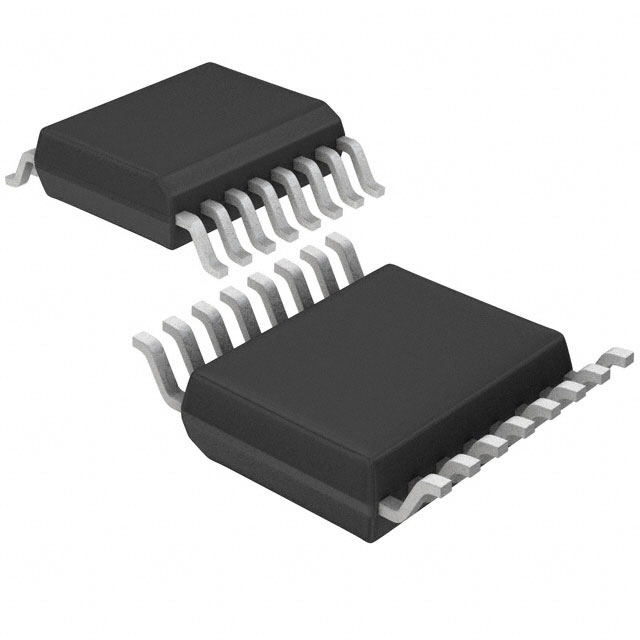LTC2654CGN-L12#PBF
Product Overview
Category
The LTC2654CGN-L12#PBF belongs to the category of digital-to-analog converters (DACs).
Use
This product is used to convert digital signals into analog voltage outputs.
Characteristics
- High precision and accuracy
- Low power consumption
- Wide operating temperature range
- Small form factor
- Easy integration into various systems
Package
The LTC2654CGN-L12#PBF comes in a 16-pin SSOP package.
Essence
The essence of this product lies in its ability to provide accurate analog voltage outputs based on digital input signals.
Packaging/Quantity
The LTC2654CGN-L12#PBF is typically packaged in reels and is available in quantities of 250 units per reel.
Specifications
- Resolution: 12 bits
- Supply Voltage Range: 2.7V to 5.5V
- Output Voltage Range: 0V to VREF
- Integral Nonlinearity (INL): ±1 LSB (Max)
- Differential Nonlinearity (DNL): ±1 LSB (Max)
- Operating Temperature Range: -40°C to +85°C
Detailed Pin Configuration
- VDD: Power supply voltage
- GND: Ground reference
- SDA: Serial data input
- SCL: Serial clock input
- REF: Reference voltage input
- AGND: Analog ground reference
- AOUT: Analog output voltage
- NC: No connection
- NC: No connection
- NC: No connection
- NC: No connection
- NC: No connection
- NC: No connection
- NC: No connection
- NC: No connection
- NC: No connection
Functional Features
- High-resolution digital-to-analog conversion
- Low power consumption for energy-efficient operation
- Wide operating temperature range for versatile applications
- Easy integration into various systems due to its small form factor
- Serial interface for simplified communication with microcontrollers or other digital devices
Advantages and Disadvantages
Advantages
- High precision and accuracy in analog voltage output
- Low power consumption extends battery life in portable devices
- Wide operating temperature range allows for use in harsh environments
- Small form factor enables space-constrained designs
- Serial interface simplifies integration into existing systems
Disadvantages
- Limited output voltage range compared to some other DACs
- Higher cost compared to lower-resolution DACs
Working Principles
The LTC2654CGN-L12#PBF operates by converting digital input signals into corresponding analog voltage outputs. It utilizes a high-resolution DAC architecture to achieve accurate voltage conversion. The digital input is received through the serial data (SDA) and serial clock (SCL) pins, and the converted analog voltage is available at the analog output (AOUT) pin. The reference voltage (REF) determines the maximum output voltage level.
Detailed Application Field Plans
The LTC2654CGN-L12#PBF finds applications in various fields, including:
- Industrial automation: Precise control of analog signals in industrial processes.
- Test and measurement equipment: Generating accurate analog signals for testing purposes.
- Audio equipment: Providing high-quality analog audio outputs.
- Medical devices: Delivering precise analog signals for medical diagnostics and treatments.
- Automotive electronics: Controlling analog functions in automotive systems.
Detailed and Complete Alternative Models
- LTC2654CGN-L10#PBF: 10-bit resolution version of the LTC2654CGN series.
- LTC2654CGN-L14#PBF: 14-bit resolution version of the LTC2654CGN series.
- LTC2654CGN-L16#PBF: 16-bit resolution version of the LTC2654CGN series.
These alternative models offer different resolution options to suit specific application requirements.
Word count: 498 words
قم بإدراج 10 أسئلة وإجابات شائعة تتعلق بتطبيق LTC2654CGN-L12#PBF في الحلول التقنية
Sure! Here are 10 common questions and answers related to the application of LTC2654CGN-L12#PBF in technical solutions:
Q: What is LTC2654CGN-L12#PBF? A: LTC2654CGN-L12#PBF is a 12-bit digital-to-analog converter (DAC) manufactured by Linear Technology (now part of Analog Devices). It is used to convert digital signals into analog voltage outputs.
Q: What is the operating voltage range of LTC2654CGN-L12#PBF? A: The operating voltage range of LTC2654CGN-L12#PBF is typically between 2.7V and 5.5V.
Q: How many channels does LTC2654CGN-L12#PBF have? A: LTC2654CGN-L12#PBF has four independent DAC channels, allowing you to generate multiple analog outputs simultaneously.
Q: What is the resolution of LTC2654CGN-L12#PBF? A: LTC2654CGN-L12#PBF has a resolution of 12 bits, which means it can provide 4096 different output voltage levels.
Q: What is the output voltage range of LTC2654CGN-L12#PBF? A: The output voltage range of LTC2654CGN-L12#PBF is programmable and can be set between 0V and VREF, where VREF is the reference voltage supplied to the DAC.
Q: Can LTC2654CGN-L12#PBF operate in both unipolar and bipolar modes? A: Yes, LTC2654CGN-L12#PBF can operate in both unipolar (0V to VREF) and bipolar (-VREF/2 to +VREF/2) modes, depending on the configuration.
Q: What is the typical settling time of LTC2654CGN-L12#PBF? A: The typical settling time of LTC2654CGN-L12#PBF is around 6µs, which refers to the time it takes for the output voltage to reach within a specified error band after a change in the digital input.
Q: Does LTC2654CGN-L12#PBF have an internal reference voltage? A: No, LTC2654CGN-L12#PBF does not have an internal reference voltage. An external reference voltage (VREF) needs to be provided to generate the desired output voltage range.
Q: Can LTC2654CGN-L12#PBF be controlled using a microcontroller or FPGA? A: Yes, LTC2654CGN-L12#PBF can be easily interfaced with microcontrollers or FPGAs using standard digital communication protocols such as SPI (Serial Peripheral Interface).
Q: What are some common applications of LTC2654CGN-L12#PBF? A: LTC2654CGN-L12#PBF is commonly used in various applications such as industrial automation, test and measurement equipment, motor control systems, audio processing, and precision instrumentation where accurate analog voltage outputs are required.
Please note that the answers provided here are general and may vary based on specific datasheet specifications and application requirements.


